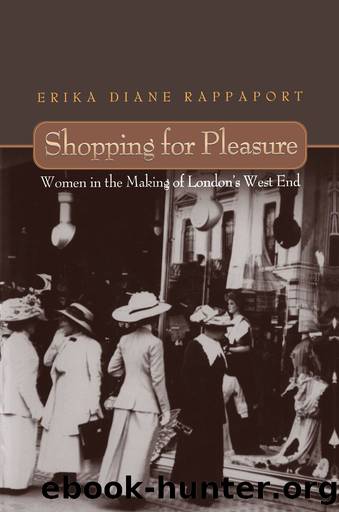Shopping for Pleasure by Erika Rappaport

Author:Erika Rappaport [Rappaport, Erika]
Language: eng
Format: epub
Tags: History, Europe, Great Britain, General, Social Science, Women's Studies
ISBN: 9781400843534
Google: uMkkEAAAQBAJ
Publisher: Princeton University Press
Published: 2021-06-08T01:13:52+00:00
SELLING TO THE MODERN AUDIENCE
The department store and the theater were not just neighbors. They were partners dedicated to igniting insatiable consumer appetites. Their relationship blossomed during the fin de siècle as they recognized a common goal, the creation of the âomnium gatherum of the population of a big commercial city,â or put simply, the mass market. This mass entity included elegantly attired ladies, well-groomed male escorts, shopmen, clerks, and spinsters, shop girls, milliners, dressmakers, typists, stenographers, and cashiers. Although clearly a congregation of buyers and sellers, this audience in the theater became a collective of consumers. The mutual aspiration to sell amusement to this modern audience contributed to a literal and figurative merger of stage and store.37
With the opulent atmosphere of the department store, restaurant, and hotel, the late-Victorian theater translated consumption into visual pleasure and specta-cle. As we have seen, the Victorian public acquired a taste for spectacle while reading magazines, walking along the streets, shopping, traveling, and visiting museums, exhibitions, and other entertainments. The theater was a part of this spectacular culture, but it had not always been so. According to one historian, early-nineteenth-century âauralâ theater only slowly gave way to highly pictorial productions that conveyed meaning as much through the look of the set and costumes as through dialogue and plot.38 By 1870, this transformation had been all but accomplished, for as the critic Percy Fitzgerald wrote, âWe go not so much to hear as to look.â Fitzgerald compared the theater to a âgigantic peep-show [in which] we pay the showman and put our eyes to the glass and stare.â When he looked at this peep show, Fitzgerald saw the commodity-filled world of the shop, the store catalog, and the bourgeois interior. He wryly pointed out that because the âmost complicated and familiar objects . . . [are] dragged upon the stage . . . when we take our dramatic pleasure we have the satisfaction of not being separated from the objects of our daily life.â âWithin the walls of the theatre,â he remarked, âwe meet again the engine and train that sets us down almost at the door; the interior of hotels, counting-houses, shops and factories.â39 To the great dismay of this critic, late-Victorian theater mimetically produced the spaces and commodi-ties of an ideal bourgeois material world.40
In mainstream theaterâespecially comedyâtrains, shops, hotels, and other sites of consumption became the locus of the bourgeois imagination. This vision helped Britons accommodate themselves to the intensely urban world they had built. As we will see, it contributed to the commercialization of the city and urban culture. If the New Drama of Ibsen and others depicted modern life as one of fraught social relations, the commercial theater interpreted it as a richly material world of exteriors, interiors, furnishings, and costumes.
This dramatic city bore a striking likeness to the urban sketches published in the popular and womenâs press. A high level of inbreeding and cross-fertilization in the literary world may partly account for this similarity. Authors like H. J. W. Dam and George Sims, for example, were adept dramatists and journalists.
Download
This site does not store any files on its server. We only index and link to content provided by other sites. Please contact the content providers to delete copyright contents if any and email us, we'll remove relevant links or contents immediately.
| Advertising | Consumer Behavior |
| Customer Service | Marketing |
| Public Relations | Sales & Selling |
| Search Engine Optimization |
Influence: The Psychology of Persuasion by Robert B. Cialdini(4716)
The Miracle Morning by Hal Elrod(4640)
The Hacking of the American Mind by Robert H. Lustig(4319)
Pre-Suasion: A Revolutionary Way to Influence and Persuade by Robert Cialdini(4153)
Unlabel: Selling You Without Selling Out by Marc Ecko(3592)
Ogilvy on Advertising by David Ogilvy(3518)
Hidden Persuasion: 33 psychological influence techniques in advertising by Marc Andrews & Matthijs van Leeuwen & Rick van Baaren(3476)
Purple Cow by Seth Godin(3143)
Who Can You Trust? by Rachel Botsman(3089)
Kick Ass in College: Highest Rated "How to Study in College" Book | 77 Ninja Study Skills Tips and Career Strategies | Motivational for College Students: A Guerrilla Guide to College Success by Fox Gunnar(3077)
The Marketing Plan Handbook: Develop Big-Picture Marketing Plans for Pennies on the Dollar by Robert W. Bly(2978)
This Is Marketing by Seth Godin(2974)
I Live in the Future & Here's How It Works by Nick Bilton(2938)
The Power of Broke by Daymond John(2900)
Building a StoryBrand by Donald Miller(2843)
The Tipping Point by Malcolm Gladwell(2829)
The 46 Rules of Genius: An Innovator's Guide to Creativity (Voices That Matter) by Marty Neumeier(2799)
Draw to Win: A Crash Course on How to Lead, Sell, and Innovate With Your Visual Mind by Dan Roam(2740)
Market Wizards by Jack D. Schwager(2645)
